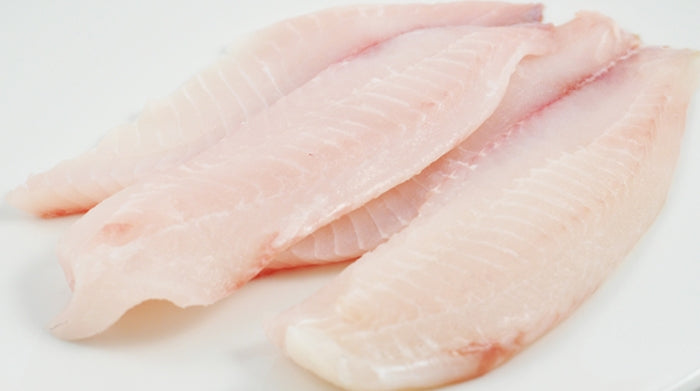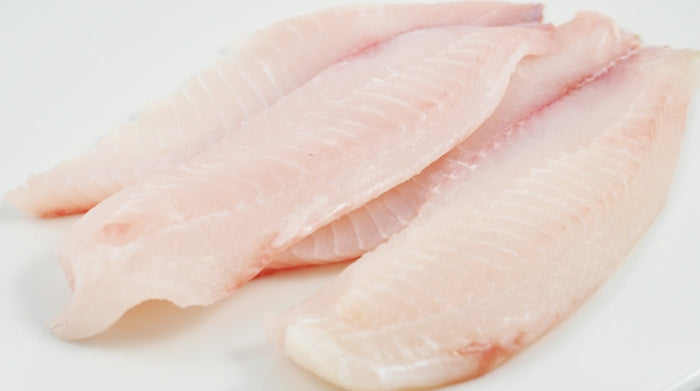Fresh Tilapia
Couldn't load pickup availability

Fresh Tilapia
About Fresh Tilapia
Mainly inhabit fresh water bodies such as; streams, rivers, ponds and lakes, it is least found in “brackish” water. Brackish water is water that has been mixed with salt water and fresh water. Over the years, tilapia have been of huge importance in artisan fishing in Africa, which is also known as traditional fishing which usually uses low technology and low capital. These fishing practices are usually taken on by individual fishing households. Their produce is consumed locally, therefore are not produced by commercial companies. Artisan fishing uses conventional fishing techniques such as the “rod and tackle”, “fishing arrows”, “harpoons” and “cash nets”.
Tilapia is a robust fish that is fed high quality, grain-based pellets to produce a mild flavoured fillet. Similar appearance to bream, tilapia are produced with a wide range of skin colours from black to dark blue to brilliant golden red. Much of the tilapia production is sold to Asian buyers as a live product and generally harvested at 1 to 1 and a half pounds. There are many different species of tilapia. Aquaculture producers have developed various breeds or hybrids that grow efficiently to market size and have desirable appearance and flavor characteristics. Three primary species in the market place are Nile or Black Tilapia, Blue Tilapia and Red Tilapia, although the species names imply different colours, the edible fillets are very similar and more influenced by growing conditions and feeds than external colours.
Tilapia is a hardy herbivorous fish that feeds on algae or small aquatic plant cells and is primarily raised in fresh water systems. The water condition in the farming operations has an important impact on production quality and taste. Tilapia has been called the “Aqua-Chicken” because of the breeding improvements and mass production methods. As the tilapia market has grown, some efforts of creatively market this species or illegally change its name to something more appealing such as sunshine snapper, cherry snapper and pink snapper. Tilapia ranks as second most cultivated fish in the world, after carp. It is also one of the most farmed fish in the world. Most of the fresh tilapia fillets consumed in the United States are produced in Honduras, Ecuador and Colombia, Costa Rica and Brazil are imported fresh daily. The United States is the largest importer of Fresh Farm Raised Tilapia Fillets.
About Tilapia Consumption
Tilapia is the fifth most popular seafood in the United States with a per capita consumption in 2007 of 1.14 pounds. Consumers widely agree that Fresh Tilapia Fillets are an excellent addition to a healthy diet. Fresh tilapia fillets are low in fat, low calorie, low carbohydrate and are extremely high in protein. It’s also an excellent source of these minerals:
- Phosphorus is found in every cell in the body and so plays a crucial role in nearly every bodily function. It helps the body use fats, protein and carbohydrates and is important in cell maintenance and repair. Phosphorus also supports growth of the skeleton and teeth, as well as the health of nerves and kidneys.
- Niacin- This B vitamin can work wonders to relieve arthritic pain and stiffness. Niacin lowers cholesterol and triglycerides. It reduces the blood fats called “very low density lipoproteins,” which have been linked to heart disease and cancer. It improves the blood sugar problems that can lead to damage of the arterial walls. It dilates blood vessels, which improves the circulation to areas starved of oxygen and nutrients.
- Selenium is involved in the production of prostaglandins in the body, which regulate inflammation and may reduce inflammation related to Rheumatoid arthritis. A study has linked selenium intake to a lower risk of prostate cancer. It also works in close conjunction with vitamin E as an antioxidant to prevent the formation of free radicals and in turn, may reduce the risk of skin cancer and prevent sunburn.
- Vitamin B12- It is needed to convert carbohydrates into glucose in the body, thus leading to energy production and a decrease in fatigue and lethargy in the body. It helps in healthy regulation of the nervous system, reducing depression, stress, and brain shrinkage. It is also essential for healthy skin, hair, and nails. In addition, it helps in cell reproduction and constant renewal of the skin. It helps maintain a healthy digestive system. Vitamin B12 also protects against heart disease by curbing and improving unhealthy cholesterol levels, protecting against stroke, and high blood pressure.
- Potassium - The health benefits of potassium include relief from stroke, blood pressure, heart and kidney disorders, anxiety and stress, as well as enhanced muscle strength, metabolism, water balance, electrolytic functions, and nervous system. Potassium plays an important role in keeping brain function at a normal level. High levels of potassium allow more oxygen to reach the brain, thereby stimulating neural activity and increasing cognitive function.
However, researchers have discovered the “possible dangers of tilapia” and have captured the media’s attention. Its reporting goes so far as to suggest that people should be warned against eating it because it might be “risky”. This illogical accusation is based on the fact that tilapia, a mild and inexpensive fish is richer in omega-6 fatty acids than it is in omega-3s. However a group of sixteen doctors agree that since fish like tilapia are relatively low in total and saturated fats and high in protein, they clearly can be a part of a healthy diet. Skinless and boneless tilapia of any variety cooks completely white, making it an excellent substitute for nearly any white fish, including sole, flounder, cod and haddock.
Research has found the inflammatory potential of farmed tilapia to be greater than a burger, doughnuts and even pork bacon. Because farmed tilapia subsists on a diet of corn and soy instead of lake plants, they’re proportionally sky high in omega-6 fats, which studies have proven to harm the heart, the brain, and even your mood. A research study that produced the tilapia vs. bacon findings revolves around this dangerous omega 6:3 proportions. The world quietly reached a milestone in the evolution of the human diet in 2011. For the first time in modern history, world farmed fish production topped beef production. The gap widened in 2012, with output from fish farming, also called aquaculture, reaching a record 66 million tons, compared with production of beef at 63 million tons. And 2013 may well be the first year that people eat more fish raised on farms than caught in the wild. One of the issues with tilapia farmed in China is that smaller, independent farmers face economic pressures to use animal manure rather than more expensive commercial feed for farmed fish, a practice which contaminates water and makes the fish more susceptible to spreading foodborne diseases. Most Chinese tilapia is farmed in ponds. Recent reductions in water use achieved by only emptying the ponds at the time of each harvest, has also reduced discharge of effluent to the environment. Chinese farms do discharge the water without relevant treatment, however, and there is evidence that some banned chemicals, including antibiotics and fungal treatments are still used in Chinese tilapia production. Overall, Chinese tilapia gets a moderate overall score of 5.34 out of ten. Tilapia as a species has the potential to be raised in sustainable ways, but the increasing intensification and industrialization has resulted in one "Red" score for the Chemical Use criterion. This means that the overall ranking is "Yellow," and therefore the recommendation is "Good Alternative."
Aquaculture of Tilapia
Tilapia is known to be the third most important fish in the aquaculture after the carp and salmon. The worldwide production however has surpassed 1,500 000 metric tons in 2002 only and increases every year. Because of tilapia’s extremely high protein content, large size, exceeding growth and also the pleasure one gets from a well-cooked tilapia; it has now become the major focus for aquaculture. The tilapia fisheries generally originated in Africa and also found in the Mediterranean. Also, outdoor aquaculture projects were inspired by the introduction of tilapia in fresh Asian water lakes. The projects are said to be done in certain countries with tropical climates. In addition, in relatively moderate zone localities, the tilapia farmers usually need a pricey energy source to help maintain a tropical range in their tanks. A relative preservation solution implicates warming the tank water using waste heat from factories.
Each bag contains 2 fillets averaging 5-7 ounces each.
When buying Tilapia online, make Anderson Seafoods your first and last source.
Buying Fresh Seafood Online from Anderson Seafoods has never been so easy, or tasted so good!
Looking where to buy Fresh Tilapia online? Anderson Seafoods brings the finest selection directly to your kitchen.
Broiled Tilapia with Thai Coconut-Curry Sauce
In this recipe, ginger, curry paste and coconut milk combine in a spicy sauce for a dish that has converted more than a few people to love this fish. The ingredients consist:
- 1 teaspoon dark sesame oil, divided
- 2 teaspoons minced peeled fresh ginger
- 2 garlic cloves, minced
- 1 cup finely chopped red bell pepper
- 1 cup chopped green onions
- 1 teaspoon curry powder
- 2 teaspoons red curry paste
- ½ teaspoon ground cumin
- 4 teaspoons low sodium soy sauce
- 1 tablespoon brown sugar
- ½ tablespoon salt, divided
- 1 (14 ounce) can light coconut milk
- 2 tablespoons chopped fresh cilantro
- 4 (6-ounce) tilapia fillets
- Cooking spray
- 3 cups hot cooked basmati rice
- 4 lime wedges
Method of Preparation
- Preheat broiler.
- Heat ½ teaspoon oil in a large nonstick skillet over medium heat. Add ginger and garlic; cook 1 minute. Add pepper and onions; cook 1 minute. Stir in curry powder, curry paste, and cumin; cook 1 minute. Add soy sauce, sugar, ¼ teaspoon salt, and coconut milk; bring to a simmer (do not boil). Remove from heat; stir in cilantro.
- Brush fish with ½ teaspoon oil; sprinkle with ¼ teaspoon salt. Place fish on a baking sheet coated with cooking spray. Broil 7 minutes or until fish flakes easily when tested with a fork. Serve fish with sauce, rice, and lime wedges.
- In conclusion, the fresh tilapia is said to be both harmful and harmless to the human body. Considering the amount of minerals that this fish contains should be well consumed by the human public, however, too much consumption of one food can be detrimental to one’s health. Consuming too much protein can interfere with your health in a number of ways such as; weight gain, extra body fat, stress on your kidneys, dehydration and leaching of important bone minerals.
Looking where to buy Fresh Tilapia online? Anderson Seafoods brings the finest selection directly to your kitchen.
Subscribe to our Newsletter
Customer Rewards Program
Our customer rewards program will guarantee that every dollar you spend with us brings the freshest catch closer to your door!



